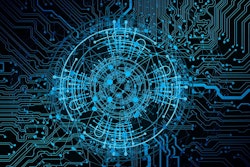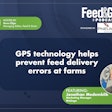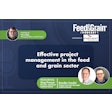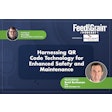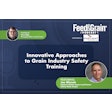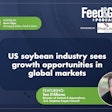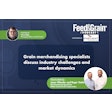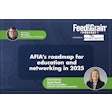Feed mill automation has come along way in the past 30 years but still has a long way to go.
Don Goshert, vice president of Sterling Systems & Controls, talks with Steven Kilger about his 38 years in feed mill automation.
The two discuss what has changed, what has not and what should have.
They also talk about current feed mill automation technology and how best to start the feed mill automation upgrading process.
This is the first of the two-part Feed & Grain podcast automation overview. The second part of the series is Future Feed Mill Automation with Brady Gaalswyk [PODCAST].
Steven Kilger 00:00
Hi, everyone. This is Steven Kilger. Just reaching out to you before we start the podcast interview with Don Goshert. The audio is a little rough. Unfortunately, we could only talk over the phone. So, it's a little messed up. But it is still a great interview, and I hope you can enjoy it as it is. Thank you so much. And on to the podcast.
Hi, everyone. My name is Steven Kilger. I am the managing editor of Feed & Grain magazine and the host of the Feed & Grain podcast. Thank you so much for joining me today. My guest is Don Goshert, and he is the vice president of Sterling Systems & Controls. He has been in the industry for over 30 years, the entire time in automation, and system control. So, I figured we would talk to him a little bit about the history of that part of the industry, and where it is at right now. He has a lot of great stories and a lot of great expertise on this topic. So, I want to thank Don. Thank you, Don, for joining me today. And I also want to ask anyone if you have an idea, for a topic or podcast guests, please go to feedandgrain.com/podcast. There is a little button there that you can submit, and it'll send a message directly to me. I'd be happy to hear from you. Thank you so much for listening. Don, thank you for joining me, why don't you tell everyone a little about yourself?
Don Goshert 01:26
Vice president of Sterling Systems & Controls, responsible for pretty much the day-to-day activities of the division. We are a division of IMI Holdings, which is a division of Industrial Magnetics. And there are 3 companies under that umbrella, Prater Industries, Sterling Controls and Industrial Magnetics.
SK 1:52
Can you tell me a little bit about your history in the feed mill automation industry?
Don Goshert 01:26
Yeah, I've been with the company for 38 years. I was a mechanical designer draftsman. I found the company really intriguing from the automation standpoint and the technology. I furthered my career by going into business classes, electrical classes, programming classes and so forth. Through the years, I was fortunate to have some very gracious bosses that gave me an opportunity to advance in the company. I was moved from drafting to helping production building panels. Going in into service was in addition to other things I was doing already. And then, a few years later, I was moved into a sales position that was extremely beneficial to go through the service part of the business and see how these systems operated and how they were built, and so forth. And design and logic. We've focused on the ag industry, feed mills in particular. I went on my first service call, and I was really caught on technology. And I was really fascinated how the feed mill changed, being automated vs. unautomated, I saw the opportunity for to take it even further, the automation and so forth.
SK 03:01
Really interesting in that kind of person. I want to talk to you for this because I want to know a little bit about the history of automation in feed. Can you tell me a little bit about what things were like when your kind of first entered what was the technology being used, what were what we're kind of breakthroughs at the time, things must have changed so much even in those 38 years.
DG 03:24
We went from proprietary hardware and software, building our own circuit boards and our competitors did the same things. They were in the same shoes that we were in. We built a microprocessor boards and boards that controlled the 120-volt real world interface. The biggest technology change that I went through in the late 80s, early 90s. We saw the evolution of the PLC, programmable logic controller, and that really changed the game for the technology. We went from using proprietary circuit boards and microprocessors to using the PLC. The PLC was didn't have a lot of memory in those days, but we used to use it in conjunction with a PC, a personal computer, and the personal computer was basically used for the data storage and the formulation and the sequencing and so forth. And it would tell the PLC to run this fan and this auger, and the PLC would do that. Then PLC would report back what the weight was. When we got to the target weight, the PC said, okay stop, weighed enough ingredients and so forth. It was very interesting, intriguing as far as seeing everybody's proprietary software, proprietary hardware just become a naughty word in in the industry and compute that proprietary customer said they don't want anything to do with it. So, we started building our control on the platform of nonpropriety hardware and the software, we have the option of proprietary as well as nonproprietary, nonproprietary is a little less expensive, proprietary is more expensive. Those were the biggest changes that I saw late 80s early 90s.
SK 05:31
Yeah, just to interject when you were building your own circuit boards and things, what kind of tasks were they able to perform?
DG 05:37
The same tasks. It was batching, weighing, mixing. The formula was limited, because memory, just like in personal computer, they evolved and as they evolved our systems evolved. Now we were 64k was all the rage the time. And as far as time passed, we became so much opportunity for advancement, we had 1000s, unlimited storage of formulas and data and so forth. The technology was the biggest change at first. The first change that I saw, it was the hardware and software for the batching process.
SK 06:22
Any other big technology breakthroughs that you've noticed over your career? That have changed the way that things have operated.
DG 06:28
The technology that I see is more on the data side. Tracking, ingredient lots, information, finished product lot information, tracking, every ingredient that goes into the mixer, and is mixed into the finished product. That then the biggest technology change in the last 15 years. Its more data driven; everything's data driven. Now, we interface with least cost formulation, software, we do a lot of ERP interfaces, with people's customers business software, telling them inventories what we had to use out of inventory into production. And then the finished product well, really tracking all the ingredients through the process and doing a really good job of being able to go back and say, okay, we had batch that didn't turn out right, and what happened. And okay, we found that one of the ingredients that was used a lot number was not as effective as it should have been, and we had to add more of that ingredient wherever the situation was to make that batch, good as they would like to be. I don't want to say recall, that's a terrible word to use. But you would be able to look at a batch and say, Okay, there's the lack of salt in the finished feed. And then we find out the salt plaewas not calibrated right or was malfunctioning. And that would be a red flag for our customers to stop that batch from getting out in the field and making it to the livestock and correct as before it was being delivered.
SK 08:30
Very, very cool. What new technology what emerging technology, do you see that might be the next big step, next big game changer in the way we automate feed mills?
DG 08:43
From my standpoint, when we're going to feed mill, they are not currently tracking the data, such as lot information automatically its being written down by hand. That is a game changer for a lot of our customers because being able to retrieve information quickly. Going digging through manual logs is time consuming, typing a lot number now you can pull up the information and see exactly where it was used, which batch it was used for and what customers needed that. Everything is so integrated from the data side. I would say 20% of our customers are there now and the rest of them are catching up, they're still doing it manually. It's a really big breakthrough for the industry more than from us, from a technical standpoint, we can do that. We have been doing that. We're very diversified. The locked in, the food industry, batching, weighing, and blending, as well as many other industries. But the ag industry is our bread-and-butter industry. It has good people. You get a person that normally is trying to solve problems, not just looking at you are saying, "what happened." It's just really a good industry to be in.
SK 10:09
It's hard not to love the ag industry is everyone is usually so nice and friendly.
DG 10:13
I think that implementing those data interface between business software on the plant floor data, as well as the customer receiving orders and filling them automatically it's almost, I hate using word that are overused but it can be so seamless and doesn't require multiple data entry points. And it's just so much more integrated than it was ever thought to be in the early years of, you know, mid 90s. We really focused on the data side since the early 2000s. And it keeps growing and growing and the more information from the batching system through the automatic inventory control, or did you ask reorder point, so your purchasing people don't have to hear from the plant that we're out of this ingredient? Or can we use in place of it, and then they get people that do the formulas involved in an afterthought. And now it's becoming more and two of them, and they're foreseen what's going to be needed in the future for inventories, and so forth.
SK 11:32
Because you mentioned that we've been able to collect data for a long time. Now the amount of data that can be collected and started to get more and more staggering.
DG 11:41
The sharing of data and as we see more and more requests, and something that we do more and more every day, integrating the data with other data systems, ERP systems,
SK 11:56
Control systems and automation, it's something I've been fascinated with, especially lately, when we have all these stories about labor shortages throughout the industry. What control systems/automation, do you think that people should really be implementing if they want to try to help themselves with labor shortages and try to reduce the number of staff that they need on site.
DG 12:16
I think about that first feed mill that I was involved in starting up. I saw three to four people just running around the place, with weigh buggies and so forth. They're working really hard. And I came back to that plant a couple of years later, and they're down to one operator. And they were adding the hand adds they added micro ingredent system that weighed 80% of the ingredients. And they were only responsible for something in 20% of ingredients. Some of them gained quite a bit of weight over the years. I was really intrigued how it changed the facility, micro ingredient systems they're the future. Right now, with the way of batching systems work, there's a lot of 50-pound bags being cut into the mixer and the need to do that is practically eliminated. Some old 80/20 rule, 80% of the weight is weighed up automatically and 20% of that is hand add ingredients. You're talking about 50 pounds or 100 pounds manually. And that's kind of the oddball ingredients that they don't run very often. Or they're just maybe weighing a quarter of a pound/ton or something like that. So, they want to do it manually and make sure they're accurate. That's one thing that I can see is a game changer for the labor shortage. We've been doing micro ingredent systems for a long time, pretty much since I've been with the company. Matter of fact, that's the first project I worked on was a micro ingredent system. And that was big labor savings. And as labor gets tighter and tighter. I see more interested in that
SK 14:07
As a young guy who has already had back surgery, at least automation has hopefully saved some employee backs right?
DG 14:13
Yeah. You're right. I mean, there's a lot of truth to that. I mean, I've been on projects that they've had a lot of worker comp issues and they're breaking 500 pounds worth of product in the mixer and one ingredient, and then 500 pounds for another ingredient and they're working hard and they're trying to make feed as fast as they can and that's the bottleneck of the system.
SK 14:42
A lot of people think when you're taking automation it will make my feed more efficient, make it faster and we'll be able to do a product out. But then there's also safety in our save all that stuff and systems are all huge benefits that might not always come to the top of mind when they're thinking about this kind of stuff. What do you think the first step should be when thinking about upgrading automation levels on a mill?
DG 15:06
Automation, the batching itself requires feedback from the field devices. And a lot of the feed mills don't have those feedback devices, like limit switches and level sensors and elevator feed and belt alignment and different things. There's kind of what I call the hidden cost of automation. The control batching system, okay its "X" amount of dollars, but you get that system to work automatically, you could spend half of the batching system costs or more just in field devices for the control system to read. Yes, automation is great. But you must really think beyond what the batching control to what is going to, turning off this auger and weigh all the ingredients into the scale. But what if the scale gate is open, and we don't know that? The ingredients are a funnel going into the next, and we're not getting any read back from the weight instrument because the gates open on the scale. So, you must have the field devices in place to say yes, the scale gates close, go ahead and start weighing ingredients. Same thing with the mixer, our mixer is mixing right now you can see the mixer motor turning flowing throughout the ingredients from the scale. the field devices are the hidden costs of the automation.
SK 16:31
That is interesting to think about, because you don't realize it. Like you said it’s a hidden cost. Speaking of general technology breakthroughs, the fact that we all have little supercomputers are pockets now.
DG 16:36
Now, they have the handheld computers that says, hey, you got alarm conditions, get back to the mill. In fact, you know, check the alarm condition. There's a lot of maintenance software that tells the maintenance staff the hours of motors and running, the bearings need to be greased. That's a maintenance module. That's kind of a thing that people rely on more and more because they are short staffed, and they can't remember everything that needs to be maintained and greased and oiled and recalibrated and so forth on a maintenance schedule. That that's something that we have incorporated in our software, as well as the remote monitoring trains that I spoke of.
SK 16:36
It’s the advantage, everything's connected, right? It's not just you're batching, we kind of have all this data coming in, so there's more and more uses for it, which is really cool. Those are the questions I have anything else you'd like to add? No. I appreciate the opportunity. well, thank you so much for talking to me today and getting this information out to our readers. I really appreciate it.
DG 16:44
Even before the cell phones, a plant was start pushing the start button and have the operations be all automated and they were delivering feed. The part that was missing when they came back to get their load. The mill might have been stopped because of the alarm condition had arisen while they're delivering feed. So, they weren't basically bound for that period of time.


